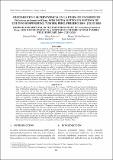Por favor, use este identificador para citar o enlazar este ítem:
https://hdl.handle.net/20.500.12958/6578| Título : | Crecimiento y supervivencia en la etapa de engorde de Striostrea prismatica (Gray, 1825) ostra nativa en sistema de cultivo suspendido, Tumbes, Perú, febrero 2019- julio 2020 |
| Otros títulos : | Growth and survival in the fattening stage of Striostrea prismatica (Gray, 1825) native oyster in a suspended culture system, Tumbes, Peru (February 2019 – July 2020) |
| Autor : | Robles, Johnny Montero, Percy Siccha-Ramírez, Raquel Guevara, Mervin Ledesma, Jesús |
| Palabras clave : | Striostrea prismatica;Ostra;Cultivo suspendido;Semilla;Tumbes;Perú |
| Fecha de publicación : | dic-2022 |
| Editorial : | Instituto del Mar del Perú |
| Citación : | Robles, J., Montero, P., Siccha-Ramírez, R., Guevara, M., Ledesma, J. (2022). Crecimiento y supervivencia en la etapa de engorde de Striostrea prismatica (Gray, 1825) ostra nativa en sistema de cultivo suspendido, Tumbes, Perú, febrero 2019- julio 2020. Bol Inst Mar Perú. 37(2): 319-337. |
| Citación : | Boletín IMARPE 37(2), 2022; |
| Resumen : | El objetivo de esta investigación fue determinar tasas de crecimiento y supervivencia, así como rendimiento en las etapas de engorde de la ostra S. prismatica en sistema de cultivo suspendido en función de los cambios estacionales de algunos parámetros oceanográficos (temperatura, salinidad y clorofila-a). En febrero 2019, se instaló un long line en las coordenadas geográficas 3°38’36,7’’S y 80°36’53,6’’O, frente a Nueva Esperanza (Tumbes). Se inició la investigación con 1.600 semillas
producidas en el Laboratorio Costero de Tumbes (Imarpe), cuyas dimensiones de valva fueron: longitud
9,3 ± 0,9 mm, altura 9,1 ± 0,7 mm y espesor 1,8 ± 0,3 mm, distribuidas en 4 linternas de 4 pisos; se empleó densidad de 100 ostras por piso. La fase de cultivo se realizó en 518 días, durante los cuales se realizaron 17 muestreos biométricos. Al final de la fase de cultivo, los promedios en longitud, altura y espesor fueron: 82,6 ± 10,6 mm; 86,2 ± 10,3 mm y 37,9 ± 6,6 mm; con tasas promedio de crecimiento de 4,3 mm.mes-1, 4,5 mm.mes-1 y 2,1 mm.mes-1. La supervivencia fue 56,0%. El análisis de varianza indicó que ambos parámetros no presentaron diferencia significativa (ANOVA, F=1,14; p=0,29). El rendimiento fue de 1: 0,1365 (1.000 kg de peso total rinde 136,5 kg de peso del cuerpo). Las condiciones oceanográficas térmicas y halinas, así como la disponibilidad de alimento (clorofila-a) fueron favorables para su crecimiento durante el experimento. ABSTRACT: We aimed to determine growth and survival rates, as well as yield in the fattening stages of the oyster S. prismatica in a suspended culture system considering the seasonal changes of some oceanographic parameters (temperature, salinity, and chlorophyll-a). In February 2019, we installed a longline at the geographical coordinates 3°38’36.7’’S and 80°36’53.6’’W, off Nueva Esperanza (Tumbes). A total of 1,600 oyster seeds produced at Imarpe’s Coastal Laboratory of Tumbes were used to start the research. The shell dimensions were length 9.3 ± 0.9 mm, height 9.1 ± 0.7 mm, and thickness 1.8 ± 0.3 mm, distributed in four 4-story lanterns, at a density of 100 specimens per story. The culture stage lasted 518 days, during which 17 biometric samplings were carried out; by the end of that stage, the averages in length, height, and thickness of the oysters were: 82.6 ± 10.6 mm; 86.2 ± 10.3 mm, and 37.9 ± 6.6 mm; the average monthly growth rates were 4.3 mm.month-1, 4.5 mm.month-1, and 2.1 mm.month-1There was a survival rate of 56.0%. The ANOVA applied to the monthly increments showed that no significant difference was found between length and height (ANOVA, F=1.14; p=0.29). The yield was 1: 0.1365 (1,000 kg of total weight yields 136.5 kg of body weight). Thermal and haline oceanographic conditions, as well as food availability (chlorophyll-a), were favorable for oyster growth during the trial. |
| URI : | https://hdl.handle.net/20.500.12958/6578 |
| ISSN : | 04587766 |
| Aparece en las colecciones: | Boletín 37(2) 2022 |
Ficheros en este ítem:
| Fichero | Descripción | Tamaño | Formato | |
|---|---|---|---|---|
| Boletin 37-2 artículo7.pdf | 969,67 kB | Adobe PDF |  Visualizar/Abrir |
Este ítem está sujeto a una licencia Creative Commons Licencia Creative Commons

